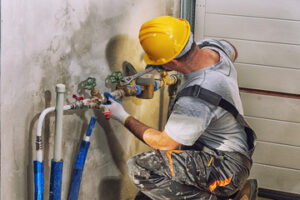Whether it’s icy winters or sweltering summers, a well-maintained HVAC system can help you enjoy a cozy home year-round. Regular maintenance helps prevent air conditioning problems and clogs. Contact Got Flow Plumbing & AC Services for professional help.

Using a full-service heating, cooling, and plumbing company can save you time and money. When you use a single contractor for your utilities, you’ll only need to call one person if something goes wrong.
Summer is a busy time of year for many homeowners. Kids are out of school, yard work is constant, and vacation plans are being made. During this busy season, sometimes the plumbing and HVAC maintenance that your home needs can fall by the wayside. The best way to prevent these minor issues from becoming major ones is by having a service plan that provides annual or bi-annual inspections and tuneups.
Aside from preventing costly repairs, having your home’s plumbing and HVAC systems regularly inspected can also help with indoor air quality. Over time, dust particles, pet dander, and pollen grains can build up in the air inside your house. This can trigger allergies and asthma in some individuals. When you have a professional plumber and HVAC contractor come to your home, they can clean out the air ducts and drain lines, which helps remove all of this material from the air and keep it fresh.
When looking for an HVAC or plumbing contractor, always look for one with a good reputation and experience in the industry. It’s also important that they offer transparent pricing without any hidden fees, and that they take the time to walk you through what will happen during each service appointment. It’s also a good idea to clear the area around your AC unit or plumbing fixtures before the technician arrives to ensure easy access and a smoother service.
Finally, it’s much easier to work with a full-service contractor than to use different companies for each individual service. If you have an issue with your heating repair, it’s easy to contact the company and reschedule. However, if you’re dealing with a plumbing emergency and have to call a separate plumber, it may be difficult to get the service scheduled in a timely fashion.
Maximizing Efficiency
One of the most time-consuming aspects of running a plumbing business is communicating with customers. Between answering phone calls, scheduling service appointments and sending appointment reminders, it can take up all of your admin team’s time. Commusoft’s customer database software automates these tasks, freeing up your time to hire more techs (which puts more money in your pocket), and improving the work experience for your existing admins so that they can focus on more complex, valuable tasks.
When it comes to maintaining your plumbing and HVAC systems, preventative maintenance is the key to long-term efficiency and optimal comfort. A routine service schedule will identify small malfunctions before they have a chance to become large problems that require expensive repairs, and can also offer benefits like increased indoor air quality and lower monthly energy bills.
For homeowners, the most obvious benefit of a service plan is that it saves on repair costs. Regular inspections and tune-ups can catch issues like clogged drains or low refrigerant levels, before they lead to a breakdown. When you’re on a service plan, you also receive priority scheduling for repair services, meaning that your issue will be addressed as quickly as possible.
Air conditioning is an essential part of keeping homes comfortable during the hot, humid summers of the Southwest. At Goettl AC, we provide a comprehensive range of AC services that ensure your system will operate efficiently all summer long, resulting in lower energy costs and more comfortable living spaces for you and your family.
For commercial buildings, a proactive maintenance program for your HVAC and plumbing systems is vital to ensuring a comfortable environment for occupants and minimizing operational costs. The expert technicians at Soul Mechanical can develop a preventative maintenance plan that’s tailored to your unique needs.
Maximizing the Life of Your System
As a homeowner, it is important to maintain your plumbing system to avoid costly repairs in the future. By signing up for a maintenance plan, your plumber will regularly inspect and service your plumbing system to catch problems before they become major issues. Additionally, a plumbing and HVAC service plan typically covers all maintenance services for a discounted rate, which can save you money in the long run.
In addition to regular air conditioning maintenance, it is also beneficial to have your home’s ductwork inspected and cleaned on a routine basis. Clogged ducts can cause poor indoor air quality and reduce the efficiency of your home’s air conditioning. In many cases, clogged ducts are a sign of dirt, mold, or mildew. Fortunately, these problems can be easily resolved by a professional technician.
Aside from improving your AC’s overall performance and energy efficiency, engaging in routine maintenance can help extend its lifespan. Properly lubricated moving parts can minimize friction and wear, which helps to protect the delicate mechanisms within your AC unit. Moreover, keeping up with regular inspections and cleanings can eliminate any debris that could impact your system’s performance.
Additionally, a regular air conditioner tune-up can identify and address minor issues before they escalate into larger ones. For example, an AC service technician can clean or replace your air filter to keep your home comfortable and prevent the accumulation of dust and other contaminants.
Lastly, regular plumbing maintenance can also help to improve your home’s indoor air quality and extend the lifespan of your pipes and fixtures. For instance, drain cleaning can prevent clogs that may lead to unsanitary conditions and foul odors, while addressing any issues with your gas line or water heater can help to protect your family’s safety.
While there are numerous benefits to using a full-service heating, ventilation, and air conditioning company for your maintenance needs, the most obvious benefit is that they can take care of all of your needs with one call. This saves time on researching contractors and can make it easier to schedule appointments.
Keeping Your Home Safe
When it comes to your home’s plumbing, you can never take too many precautions. Keeping drains clear of hair, food scraps and other debris is one way to prevent clogs. Other simple measures include installing toilet locks to keep curious little ones from playing in sanitary water and throwing toys inside that can lead to sewage backups. It’s also important to have a list of emergency contacts and to install a carbon monoxide detector in your home.
Your home’s HVAC, plumbing and electrical systems are essential for your comfort and safety, so make sure to schedule maintenance to keep them functioning properly. For more information about our heating, air conditioning, plumbing and whole-home generator services, please call Eco Home Solutions in Memphis, TN today! We offer sales, service and installation of HVAC systems, plumbing and generators throughout the area. We are a locally owned and operated company that prides ourselves on providing the best customer experience possible.

